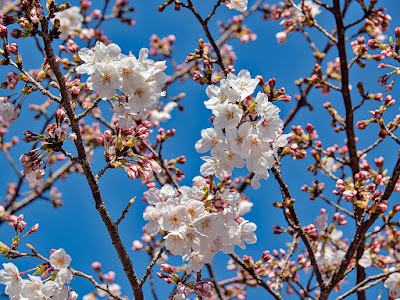My photographic notes about the four seasons in Kamakura or the gardens of Zen
March 29, 2020
Haku-mokuren (Yulan magnolia) flowers: Engaku-ji
Earlier than usual this year, the countless flowers of this old tree have just burst into full bloom in unison to hurriedly participate in the race for pollination in spring.
The bright white flowers, which look like the sacred lotus flowers floating in the air, seem to fill the blue sky above my head and are emitting their grace and fragrance for inviting the insects and birds which help pollinate these flowers.
As soon as the pollination is completed, the snowy petals of these magnificent flowers rapidly begin to decay and to fall one after another in the mild spring breeze.
Mitsumata (Edgeworthia chrysantha) flowers and Akatateha (Vanessa indica) butterfly: Engaku-ji
After awakening from long winter sleep in the hiding place, a small butterfly has begun fluttering about busily to search for sweet nectar in the bright sunlight of spring.
The vivid yellow flowers of Mitsumata are blooming quietly and giving out the scent of nectar to invite insects to their mystic ritual of pollination.
A flower and a butterfly meet each other of their own accord owing to the unknown affinity kept for hundreds of million years, which tells me about a secret story of life continuing unendingly in our universe.
Haku-mokuren (Yulan magnolia) flowers: Engaku-ji
Throughout this vast universe, the mind must be omnipresent and dwell in every living thing in various forms.
On our planet earth, like other living things, trees and plants must also have their own mind and must feel pleasure and pain in a way that I can never know.
I never know whether or not a tree or plant has greed, hatred, and delusion just like a human being.
Without displaying or telling anything about their mind, trees and plants continue to live and grow silently in the swift and ceaseless passage of the seasons.
March 11, 2020
Spring garden: Tokei-ji
In the spring garden flooded with the bright sunlight, trees and plants are silently competing with each other to grow lively here.
The pleasant fragrances of the living things just woken from their winter sleep are floating gently in the air to make me feel the joy of spring.
The pale pink flowers of Ume are surrounding the bronze statue of Shaka Nyorai (Shakyamuni Buddha) and are shining softly like the radiant light of great compassion which is emitted by this sacred image.
Ume (Japanese apricot) flowers: Tokei-ji
Before any other flower, Ume flowers begin blooming in the cold of February to silently announce the incoming of long-expected spring.
Under the wintry sky, these flowers come into bloom dignifiedly on the dried and bare branches and emit their faint but fragrant scent into the chilly air.
In East Asia, it is said that a precious flower of Ume symbolizes the image of an innocent and pure young lady because of its virtue of noble blooming.
Byakusin (Juniperus) flowers: Engaku-ji
In the front yard of the Hojo (main hall), an old Byakusin (Chinese juniper) tree is standing still in solitude for hundreds of years like a Zen monk who keeps meditating everlastingly.
Every spring, this aged tree bears a great number of humble yellow flowers as if to be grateful for the return of the beautiful season of regrowth.
According to the style of architecture of the Zen temples introduced by Sung of China, evergreen Byakusin trees are planted in the frontcourt of Butsu-den (Buddha hall) as the symbol of the state of perfect enlightenment.
Subscribe to:
Posts (Atom)























